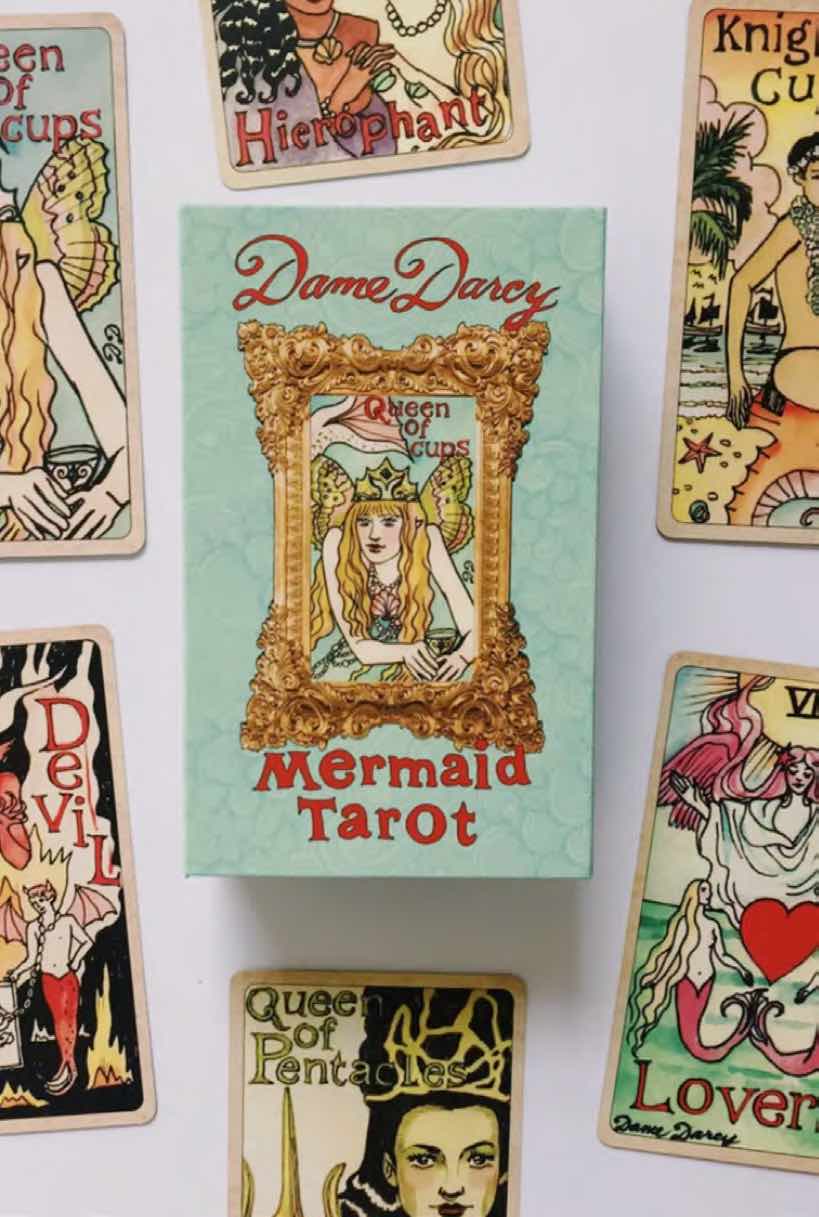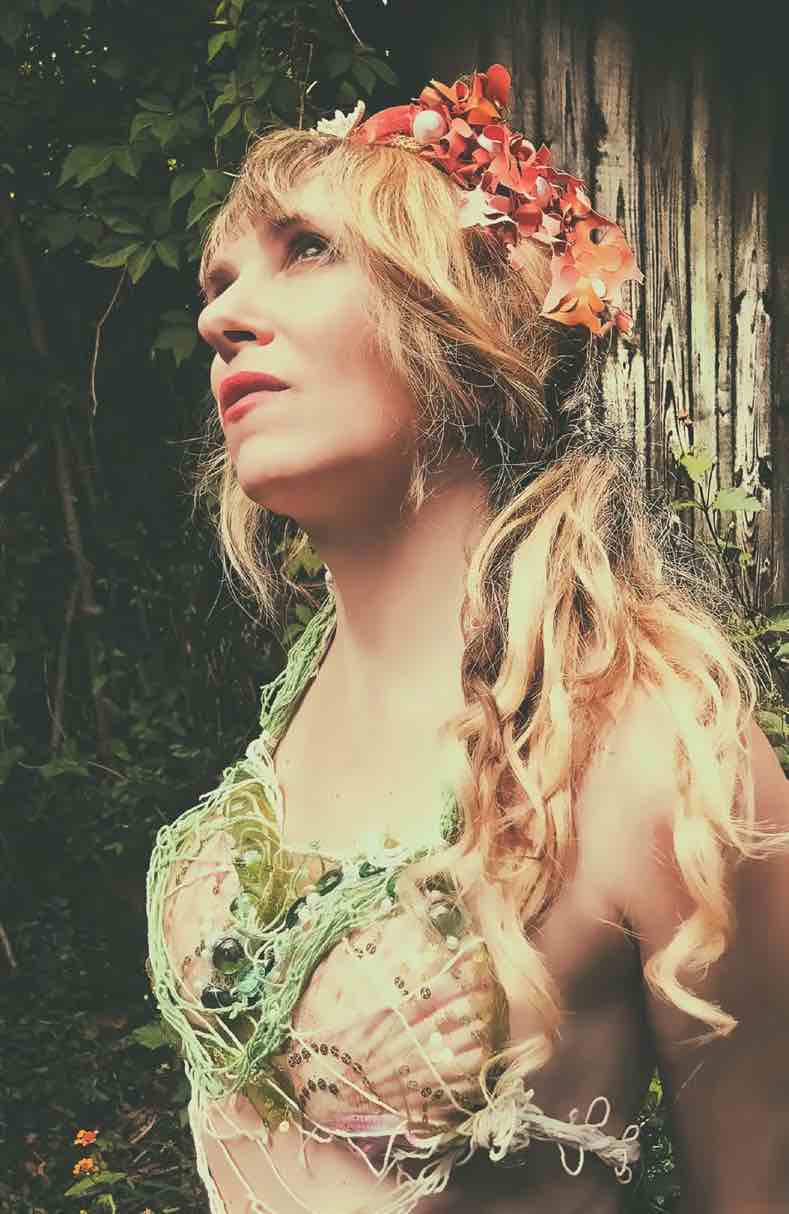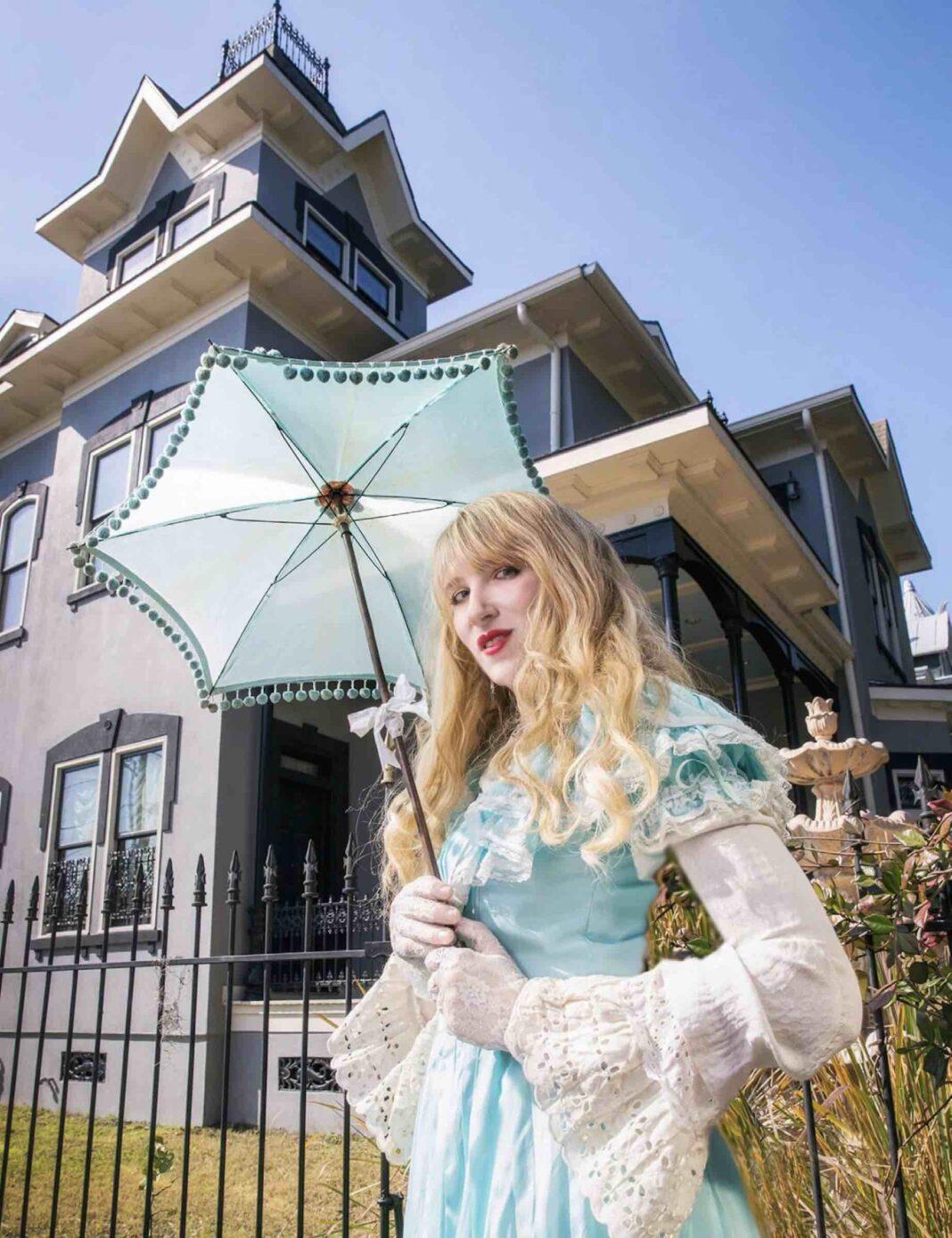It feels like fate that Dame Darcy—equal parts mermaid and witch, a longtime artist, filmmaker, writer, tarot designer, musician, and haunted-doll-whisperer—should find herself at home in Savannah, Georgia. Savannah, like Darcy, exists in a place between the land and the sea, between the living and the dead, where your neighbors might be ghosts, where the saltwater-tinged air hangs with a sultry floral perfume of flowers that may or may not be poisonous, where shimmering veils of water dance upon ornate fountains and centuries-old grand oak trees exude their tattered grace, draped with heavy gray-green plumes of Spanish moss, swaying gently on the evening breeze.
Kambriel: Having lived in many different parts of the country, including Idaho and New York City, what ultimately drew you to Savannah?
Dame Darcy: There was a day when I was in my apartment in Chinatown in New York City, looking up Ludlow Street toward the Empire State Building. I got a vision of a place that looked tropical and had big tall palms, but Colonial-style architecture, and pirate treasure buried on an island in a waterway.
I didn’t know where this mermaid paradise place was, but I knew I was being led there by the Goddess and would find my treasure there, in all senses of the word. With this new revelation, I began searching for a more cottagecore-type option to buy a house, grow a garden, and live a more sustainable off-the-grid lifestyle like how I’d grown up. I looked at Trinidad, Uruguay, Argentina, Mexico, the Canary Islands, Jamaica, Brazil—then my friends had a wedding in Savannah and it looked just like my vision.
The spirit of Savannah draws its own to itself. Savannah kept whispering to me, and I’d forgotten her name from another lifetime. She was born in the 1700s, after all, and is very old for America. By living here, I’ve been able to live with low overhead and put my savings back into my online business and grow it to the point where I could buy a home—an adorable coral pink and sea-foam green Florida-style bungalow with lots of tropical plants on a street named after a tropical flower. I share it with my fiancé, Pleasant, who I found here in Savannah. The spirit of Savannah is like a beautiful black lady all dressed up in her Antebellum finery ready to go to the cotillion, except her dress is a little ripped and dirty, dripping with Spanish moss. When she lifts up her skirt to dance, hundreds of feral cats and palmetto bugs scurry out from under the ripped lace.
K: I can see you commandeering a pirate ship in centuries past, if not next week! What are some things about the nautical world you feel an affinity with?
DD: The best pirate tale, and the life I aspire to, is The Count of Monte Cristo. Put in prison wrongfully by people with more privilege who were jealous of him, the Count got out and found the pirate treasure and showed them that “living well be the best revenge! Yarrr!” As a kid I read Treasure Island, Moby Dick, Swiss Family Robinson, Pippi in the South Seas, Robinson Crusoe, Peter Pan, Slocum’s book Sailing Alone Around the World, and anything else I could find to live in that pirate fantasy. I knew as soon as my stint in Idaho was up, I would live in port towns the rest of my life and go to sea when I wanted, and never be forced to be with landlubbers again. My mom is originally from Pasadena, so she took us to see her family and go to the beach in Los Angeles and San Clemente. I loved surfing and swimming in the ocean spray, and watching the sunset over the water. It got into my heart. When she took us to Disneyland and we went on the Pirates of the Caribbean ride, I wanted to just live there. I knew it was an installation made to look like somewhere, but I didn’t know where. So I started my search to find it.
Captain Cook buried his treasure on one of the sixteen barrier islands near Savannah on the Intracoastal Waterway, and I’m going to get the gold. The lure of actual pirate gold is indescribable to landlubbers. It’s not even about the money. It’s like a haunting ghost that calls you constantly, and maybe the lure is the shine of hope—that something is always out there waiting for you to find it.
As soon as I moved here, I started crewing and living on boats on Hilton Head Island and began getting to know the Intracoastal Waterway. I went to sea school on Hilton Head Island to get a captain’s license—I learned some celestial navigation, how to determine drift on charts, and the locations of the islands here where the vision showed me where the gold is. Longitude, latitude, the rules of sailing, wind, knot tying, and all kinds of other nautical stuff. During this time I also wrote the script I’m basing the next Meat Cake graphic novel on, entitled Meat Cake, the Voyage of Temptress. It’s a pirate adventure that takes place on the H.M.S. Temptress, and also a time-travel tale with witches and mermaids.

K: You’ve created several tarot decks with various themes—Mermaid, Witchy Cat, Queen Alice. How were you first introduced to tarot reading?
DD: My introduction to tarot was through Mom. She was probably only in her early twenties at the time—a vision of her reading the Rider-Waite-Smith deck for her friends on a round table in front of a crackling fire on New Year’s night is one of my cherished first memories, at age five. Her long hair hung like a veil as she placed the cards in a pattern. The colorful holiday lights were strung around the room and reflections of the shadows glittered off the icicles hanging outside the window as she told her friend’s future. The room felt cozy and mystical at the same time and left an impression of enchantment on me. From then on, I was hooked for a lifetime on tarot reading.
I drew all three sets with the intent of finding other enthusiasts and magic people who love the Rider-Waite-Smith as much as I do. My partner Pleasant did the graphic design and packaging of the cards, and I illustrated and painted them. Now our new Musings and Meanings tarot book and journal to go with all Rider- Waite-Smith-based decks has been released at damedarcy.com! We both picked out the color palettes for everything, so this was very much a collaborative effort.
The oldest, Mermaid Tarot, was inspired by the nautical world we love and live in, here in subtropical Savannah. With mermaids, sailors, pirates, and sea life, I wanted to create an LGBTQ deck based on Rider-Waite-Smith that represented all races. The color palette is my favorite—sea-glass green, aquamarine, gold, sand, with a border that looks like a tan, weathered pirate map, navy blue and red accents. She’s still our most popular deck ten years later, and I can’t tell if it’s because she has been circulating the longest or because divining with the Mermaid Tarot is like a deep dive into a mermaid’s soul. It has meant so much to be in touch with other mermaids and tarot readers through this deck. I feel she has the most bubbly, light, and playful vibe of all the decks.
K: In addition to visual arts, you’re also a musician whose music captures a certain haunting charm from the days of yore. Your sea shanties, and their narrative style, really suit your natural penchant for storytelling.
DD: Sea shanties are part of my family legacy, but I usually felt alone in my passion for them. I was glad they trended, so finally someone understands what kind of music I perform. My dad was in the navy and taught me to play sea shanties on the banjo when I was a kid. My first sea shanty was “Greenland Fisheries,” and the story of the tragedy of the whale hunt led me into a world I couldn’t get enough of.
I like how hardcore sea shanties are—they are like the punk songs of the 18th century: sometimes silly and irreverent, with a lot of nautical in-jokes, dark humor, and bawdy-sexy connotations. Some are very serious, written for shipmates who died. Many were drinking songs that doubled as songs to keep the sailors’ morale up while they did heavy manual labor. They are often about shipwrecks, leaving loved ones behind, and drowning. Translated from many languages, including French, German, and Old English, and sprinkled with Celtic Gaelic and old-time nautical phrases, sea shanties create their own language and share a narrative about how difficult but poetic life can be—written from the perspective of sailors, male and female pirates, and the ladies who love them … even mermaids!

K: You strike me as someone who has never not created art. What are some of your earliest memories of art? Do you remember when you began trying your hand at making art of your own?
DD: I grew up playing with porcelain dolls handed down from my great-great-great grandma. They were so old, their hair and clothes were disintegrating, so we sewed new ones and Mom glued her own hair to them. That’s why I’m like this—we were raised in the 1970s and ’80s like it was the 1880s. I thought Little House on the Prairie was a show set in current times.
I’ve always known the metallics of Klimt paintings and how gold can reflect dark or shine bright. Rococo fashion, Art Nouveau furniture, and the Art Déco design of Erté. Waterhouse paintings and the pre-Raphaelite academics who based their works on Greek mythology and Arthurian legend. The pen and ink illustration of Aubrey Beardsley, the writing and poetry of Oscar Wilde, and the beautiful world he created with his details and wry wit. There was the classic turn-of-the-century world building of the original Wizard of Oz series and their imaginative pen and ink illustrations and of course the Alice in Wonderland books from the 1860s. At the time, I didn’t understand that most people I’d meet wouldn’t know anything about the things I held most dear, and when I met anyone who did, I would cry with delight at being understood.
I also saw Zap comics from the 1960s and loved Tales From the Crypt comics from the 1950s, which showed women as old hags, sexy scary witches, pretty ghosts, and ax murderers in all kinds of fabulous roles beyond the sex objects or moms I saw in mainstream media. I loved Edward Gorey and The Addams Family cartoons and read the Hernandez brothers’ comics on Fantagraphics as a teen. All this showed me I could have a career as an alternative cartoonist and graphic novelist when
I had the opportunity—that there was a place for me in the world, and if my art had a classic style it would never go out of style.
My parents and great grandma encouraged me to draw and write the picture books I was so passionate to make as a child. I started drawing illustrated books at age two and was so excited to be able to read and write. Mom would take the pages I drew and type the words at the top that I dictated as the story. She also read us fairy tales and classic stories every night.
Discover more about Dame Darcy at damedarcy.com. Visit Kambriel online at kambriel.com.
K: You’re a creature with a seemingly endless depth of creative energy and a long and always growing legacy of artistic creations. How do you see yourself at your core—your driving force? What is your best hope for what you can communicate via your work?
DD: Picture books, graphic novels, and comic books will always be a perfect way to engage all ages. Publishing is really creating a legacy. When I read Oscar Wilde as a kid, I didn’t understand his voice was coming to me from a century ago—his work is so contemporary. I didn’t know until later that my beloved Oscar Wilde was persecuted and tortured in prison for being gay. This broke my heart and is why I still identify as LGBTQ, an advocate for all things as beautiful and bitchy as my dear Oscar. Once I understood what a century was and how many of the things I loved were centuries old, I vowed to make books that kids in 2175 would find in a dusty attic to enrich their lives and make them laugh the way the books I had did. Fairy tales are one of the only ways we have recorded women’s history. In many of the tales told by teen girls and grandmas to children while they babysat and the parents were away working, the main protagonists were young women or children and the bad characters served as warnings to watch out for predatory men or not to marry a lazy husband or be lazy, and to have morals yourself. This was all changed when the Brothers Grimm, with their patriarchal agenda, recorded the folk tales and changed the bad people into witches. But the truth still shines through.
K: What would you love to be able to inspire in others?
DD: Magic beings need to know that they don’t need to change to fit in. You are already perfect and unique. At every age, everywhere, every race and gender. Diversity in everything is integral to life, and society is flawed, not you. By celebrating our rare individuality and aspiring to be our best selves, we can make a better world.


































